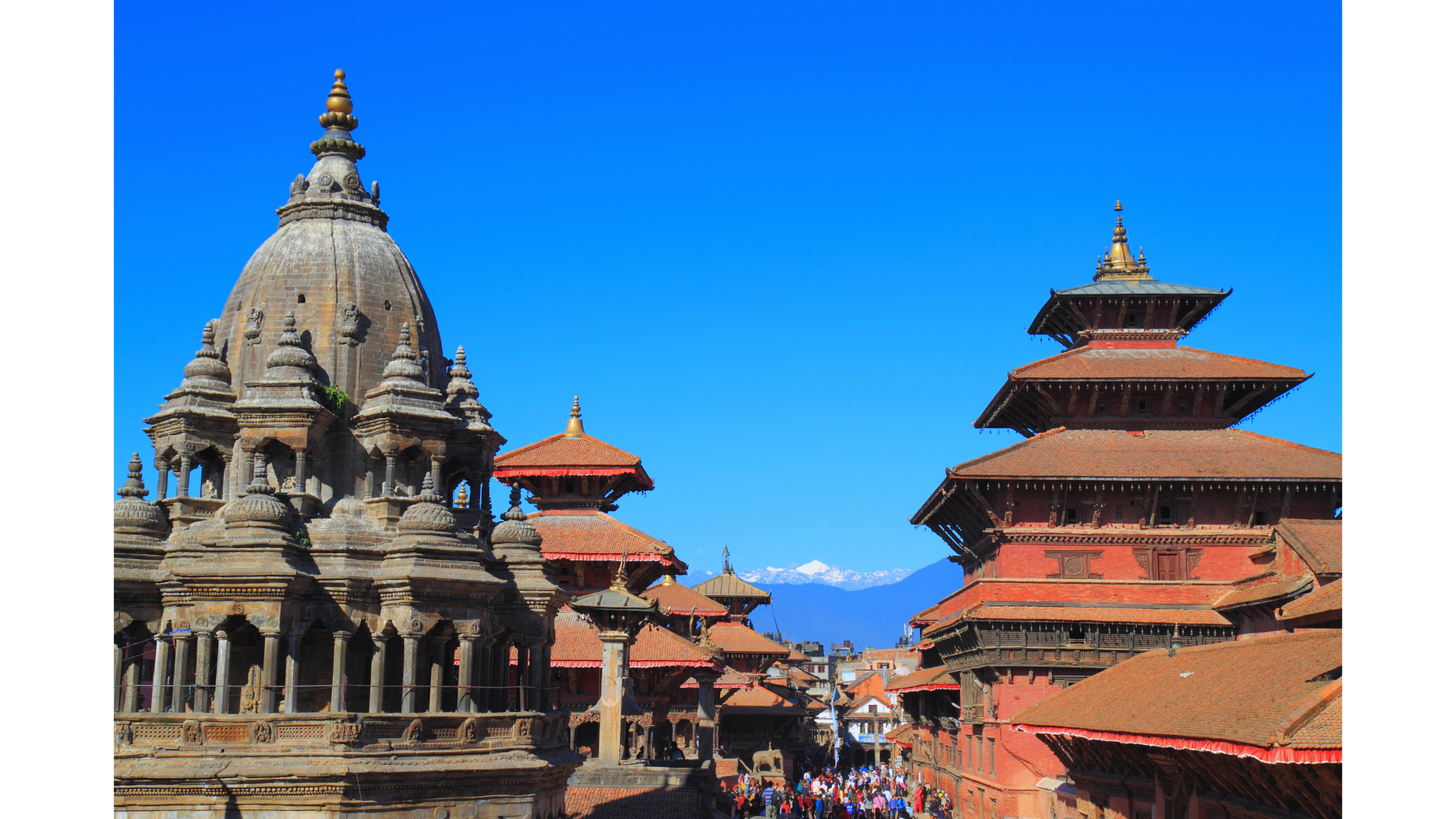
Patan Durbar Square, located in Lalitpur, Nepal, is a UNESCO World Heritage Site. This stunning square is a blend of rich cultural history and architectural beauty, showcasing centuries of Nepalese craftsmanship. Whether you’re passionate about art or fascinated by history, Patan Durbar Square offers a unique experience that captures the essence of Nepal’s past. Its vibrant temples, royal palaces, and intricate sculptures make it a must-visit for anyone exploring Nepal’s cultural heritage.
The Fascinating History of Patan Durbar Square
Patan Durbar Square, originally known as Lalitapattan, dates back to the 3rd century BC, making it one of the oldest settlements in the Kathmandu Valley. Flourishing under the Malla dynasty (12th–18th century), the kings were strong patrons of the arts, leaving behind magnificent temples, palaces, and courtyards. Over time, the square grew from a small town into a cultural, trade, and religious hub. Today, it stands as a living museum, preserving Nepal’s rich architectural and artistic heritage for future generations.
Explore the Architectural Wonders of Patan Durbar Square
One of the main attractions of Patan Durbar Square is its remarkable architecture. The square is filled with Newari-style buildings, featuring intricate carvings and ornate pagoda temples. These structures reflect the fusion of Hindu and Buddhist influences in Nepalese culture.
Krishna Mandir: A Masterpiece of Shikhara Architecture
The Krishna Mandir is a three-story temple built in 1637. This stunning stone structure is the first example of Shikhara-style architecture in Nepal. The temple features elaborate carvings of Hindu deities and mythological figures, making it a must-see.
Mahabouddha Temple: A Blend of Buddhist and Hindu Traditions
The Mahabouddha Temple is another gem in Patan Durbar Square. Known as the “Temple of a Thousand Buddhas,” its terracotta structure represents the harmony between Hinduism and Buddhism in Nepal. The peaceful atmosphere offers visitors a serene escape.
Patan Museum: A Glimpse into Nepal’s Artistic Legacy
Housed in the former royal palace, the Patan Museum showcases an impressive collection of art and historical artifacts. The museum offers a deeper understanding of the region’s rich cultural and artistic traditions.
Cultural Importance of Patan Durbar Square
Patan Durbar Square is more than just a historical site; it serves as a vibrant hub of cultural activity, deeply rooted in local traditions. The square hosts several festivals throughout the year, with the Kumari Jatra, or Living Goddess Festival, being one of the most significant. This celebration honors the Kumari, the living goddess of Nepal, and features lively processions, traditional dances, and music that engage both locals and visitors. Another major event, the Machhindranath Jatra, is a grand chariot procession celebrating the Rain God, with colorful parades and a festive atmosphere that create an unforgettable experience for all who attend. These festivals bring the square to life, adding to its cultural richness and importance.
Discover the rich history of Swayambhunath
Traditional Arts and Crafts of Patan Durbar Square
In addition to its stunning architecture and vibrant festivals, It is renowned for its rich tradition of arts and crafts, showcasing the exceptional skills of local artisans. The square is a living testament to the ancient craftsmanship of woodcarving, with artisans creating intricate designs ranging from religious figures to decorative panels that continue to capture global attention. Pottery, another prominent craft in the square, is produced using traditional methods, with artisans crafting beautiful clay pots by hand, reflecting Patan’s timeless artistic heritage. Additionally, Patan is famous for its weaving and metalwork, with local artisans creating high-quality silk and cotton textiles, as well as intricate bronze, copper, and brass sculptures, sought after both domestically and internationally.
Why You Should Visit Patan Durbar Square
Whether you’re captivated by history, fascinated by art, or interested in cultural traditions, Patan Durbar Square offers something for everyone. The square is a vibrant blend of the past and present, making it a must-visit destination in Nepal.
It is not just a historical landmark; it is a living, breathing part of Nepal’s cultural fabric. Visiting this site allows you to connect with the country’s heritage and experience its timeless beauty.
Conclusion
In conclusion, Patan Durbar Square is a must-see for anyone visiting Nepal. With its stunning architecture, lively festivals, and rich cultural traditions, it provides an unforgettable experience. So, if you’re looking to immerse yourself in the heart of Nepal’s heritage, It should be at the top of your list.
Frequently Asked Questions
1. What is Patan Durbar Square?
A UNESCO World Heritage Site in Lalitpur, Nepal, known for its rich history and stunning architecture.
2. When was Patan Durbar Square built?
It dates back to the 3rd century BC, flourishing under the Malla dynasty (12th–18th centuries).
3. What are the main attractions in Patan Durbar Square?
Notable sites include Krishna Mandir, Mahabouddha Temple, and Patan Museum.
4. What festivals are celebrated at Patan Durbar Square?
Major festivals include Kumari Jatra (Living Goddess Festival) and Machhindranath Jatra (Rain God procession).
5. Why is Patan Durbar Square culturally important?
Patan Durbar Square preserves Nepal’s architectural, artistic, and cultural heritage, continuing to influence local life.
DEX analytics platform with real-time trading data – https://sites.google.com/walletcryptoextension.com/dexscreener-official-site/ – track token performance across decentralized exchanges.
Privacy-focused Bitcoin wallet with coin mixing – https://sites.google.com/walletcryptoextension.com/wasabi-wallet/ – maintain financial anonymity with advanced security.
Lightweight Bitcoin client with fast sync – https://sites.google.com/walletcryptoextension.com/electrum-wallet/ – secure storage with cold wallet support.
Full Bitcoin node implementation – https://sites.google.com/walletcryptoextension.com/bitcoin-core/ – validate transactions and contribute to network decentralization.
Mobile DEX tracking application – https://sites.google.com/walletcryptoextension.com/dexscreener-official-site-app/ – monitor DeFi markets on the go.
Official DEX screener app suite – https://sites.google.com/mywalletcryptous.com/dexscreener-apps-official/ – access comprehensive analytics tools.
Multi-chain DEX aggregator platform – https://sites.google.com/mywalletcryptous.com/dexscreener-official-site/ – find optimal trading routes.
Non-custodial Solana wallet – https://sites.google.com/mywalletcryptous.com/solflare-wallet/ – manage SOL and SPL tokens with staking.
Interchain wallet for Cosmos ecosystem – https://sites.google.com/mywalletcryptous.com/keplr-wallet-extension/ – explore IBC-enabled blockchains.
Browser extension for Solana – https://sites.google.com/solflare-wallet.com/solflare-wallet-extension – connect to Solana dApps seamlessly.
Popular Solana wallet with NFT support – https://sites.google.com/phantom-solana-wallet.com/phantom-wallet – your gateway to Solana DeFi.
EVM-compatible wallet extension – https://sites.google.com/walletcryptoextension.com/rabby-wallet-extension – simplify multi-chain DeFi interactions.
All-in-one Web3 wallet from OKX – https://sites.google.com/okx-wallet-extension.com/okx-wallet/ – unified CeFi and DeFi experience.

Leave a Reply